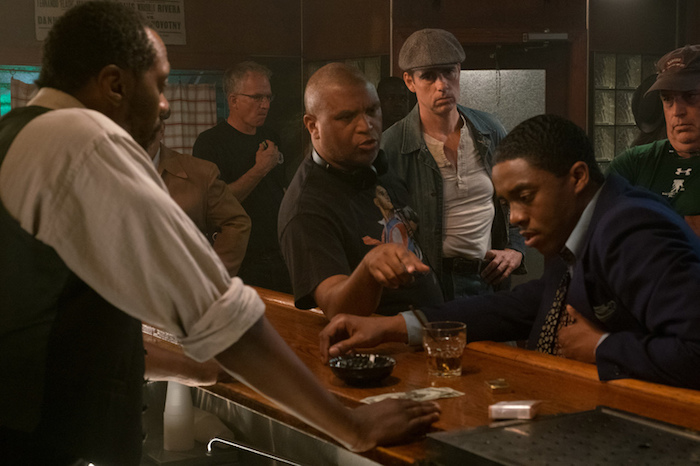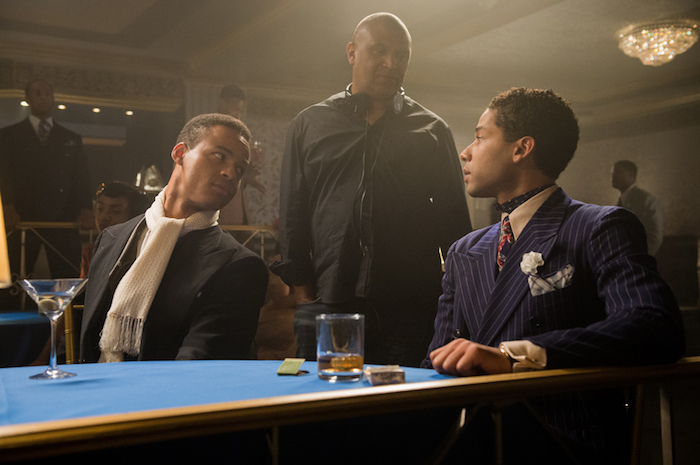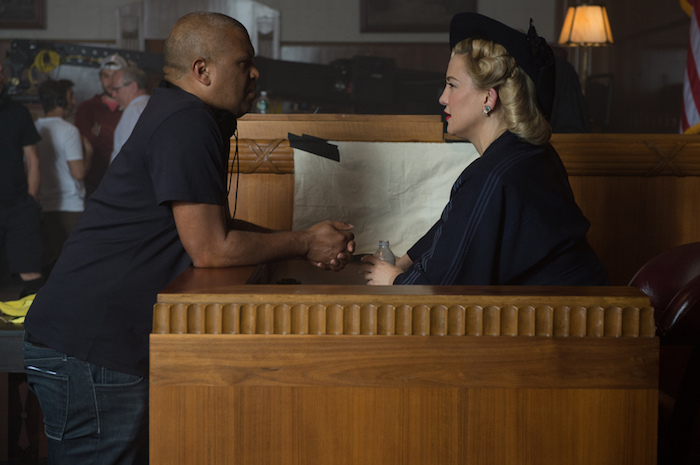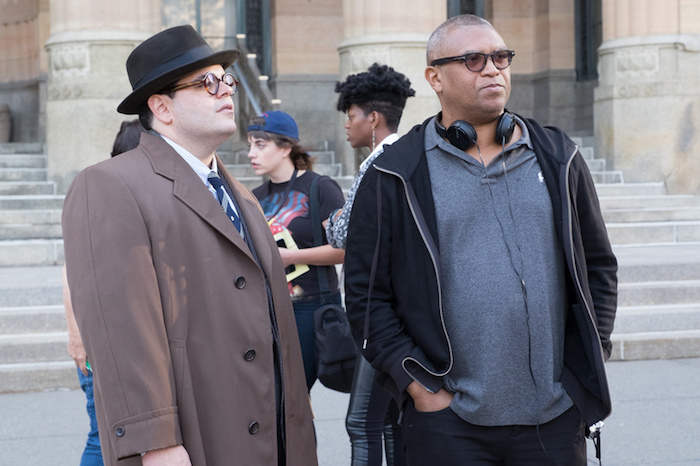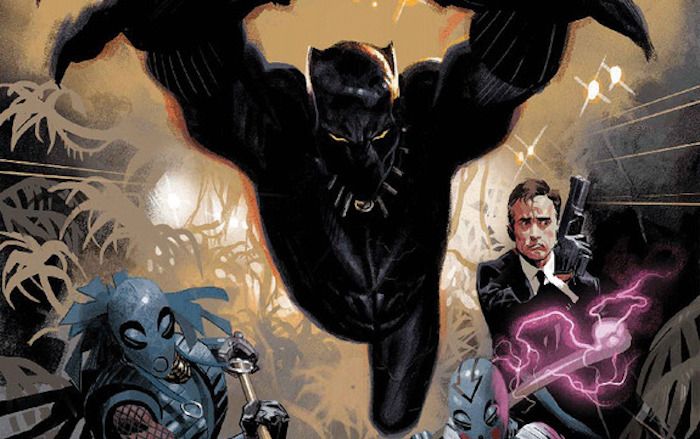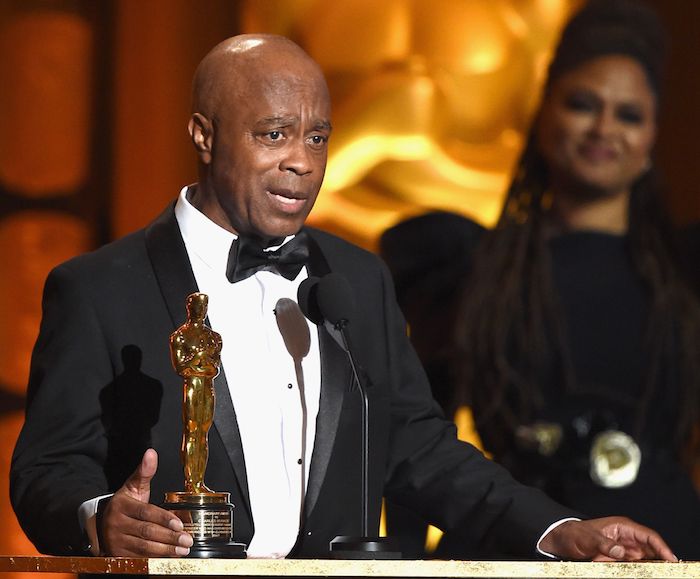One Man #JusticeLeague: In Conversation with MARSHALL Director Reginald Hudlin
By Thembisa S. Mshaka, Contributor
Marshall opened on October 13, preceded by a world premiere at the Urbanworld Film Festival, where the director and cast spoke, with family members of both Thurgood Marshall and Sam Friedman in attendance. Marshall may be an historical biopic, but its genius lies in focusing on one case Marshall argued, and the unlikely but critical alliance between Marshall and Friedman (played by Chadwick Boseman and Josh Gad respectively), two attorneys who realize they have more in common than either imagine. Hudlin makes a period piece courtroom drama modern and absolutely relevant for today’s moviegoers by placing the unflappable Black legal ace and the inexperienced but steadfast Jewish lawyer at the center.
Fast forward four weeks to the release of LBJ, starring Woody Harrelson. It is a biopic on the President who appointed Marshall to the Supreme Court. Once again, we have the Old White Man driving the narrative. And while I haven’t seen this particular film, we have all seen this formula. Create Oscar® vehicle for the leading man. Tell the story of American oppression from the vantage point of the dominant group. Revise and dilute history for box office receipts. Repeat. While the production budget is not public, what we do know is that LBJ grossed under $2M opening weekend. The takeaway for Hollywood to finally understand here is this: we’ve seen this movie. Audiences keep trying to tell you. Time for new perspectives, new voices and new approaches. What else is there to lose at this point but money?
In this age of immediate posting of articles, I often find myself taking my time to craft mine. Blame it on my training in weekly print as a former magazine editor. In this case, it served me well to wait; I also had to wait for Hudlin to be available to chat. He was on an award tour with Chadwick tha man, promoting the film to youth, corporations, and grassroots organizations ahead of the Black Panther media blitz.
On December 3, Hudlin will be recognized as a champion of inclusion with the Bill of Rights Award from the ACLU of Southern California. Hudlin and I sat down on Google Hangout to talk remixing Mount Rushmore, why #BlackCreativesMatter, and most importantly of all, why Marshall, a veritable Justice League of one at the dawn of civil rights, matters in the age of fake news, fraudulent government officials, and American fear of the inevitable: power sharing.
TSM: What is your personal connection to Thurgood Marshall?
RH: I was in elementary school and I always thought he was underrated as a great American; even in the Black community. I thought he should be up there with Harriet Tubman, Martin Luther King, and Malcolm X. Along with Thurgood Marshall, they are myMount Rushmore. Three are rule breakers; breaking the law in search of justice. Thurgood is the only one who makes the law—and I feel like that’s the next level we have to go to as a people.
TSM: The film centers on one case among many he took on. What was the most impactful part of his legacy for you?
RH: The totality of his existence. Brown v. Board of Education is massive, but that is one of five major rulings as a Justice which transform the country, making our laws more equitable. Symbolism matters. [Marshall] is important in the same way as Barack Obama is as a President, but their presence is much more than symbolic.
TSM: Which of his attributes do you admire most and why?
RH: His sense of humor takes people by surprise. George Clinton (of Parliament Funkadelic) said, “nothing is good unless you play with it”. [Marshall] was a prankster. He had a playful scholastic mind; an extension of the innvovation that led to him to coming up with such unique arguments in court.
And then there’s the arrogance—a device he uses in battle. He walks into a courtroom of white people and says, ‘I’m gonna make you change your mind’.
TSM: To what can we attribute to a lower profile of Marshall as a figure of the Harlem Renaissance? His name tends not to ring among the creatives of the day.
RH: We tend to think of these figures in silos, but they all moved together. Thurgood Marshall went to Lincoln University with Langston Hughes. In Harlem, he lived in the same building as Walter White, and Duke Ellington lived across the way. [By having Marshall, Hughes, and Hurston in a scene together] I wanted to connect them for the audience in the same way the movie connects the Holocaust with the Civil Rights battle—to remind them they are all happening at the same time.
TSM: When did you decide to get a movie made about Thurgood Marshall?
RH: I have a running list of movies I want to make in my head. Windows of opportunity open and close. Over the years, you develop a reputation as a certain kind of director.
TSM: Like a blackity Black one?
RH: (Laughs) well, that—but also as a lover of history. Paula Wagner brought the script to me knowing me as a storyteller.
The original script needed to have the movie centered on Marshall instead of being The Trial of Joseph Spell.
TSM: How did the script come to Wagner?
RH: This is such a great story. Mike Hoskoff wrote the script and sent it to Friedman’s daughter for her thoughts. She loved it—and called Paula Wagner, who also loved it and called me.
TSM: Talk about the estates of Marshall and Friedman, and the value of their involvement. What key ways did it contribute to the film?
RH: Their involvement was very important. It got us our star. Chadwick was reluctant to play another historical figure period—but we also knew we wanted to find a way to work together. He read it as a favor, and he was still reluctant and unsure about whether it was the right thing to do. So I went to the Marshall family and asked them about it. They wrote a wonderful letter asking Chad to play the role. Essentially, it said, “if you told their father the best person for the job was turned down because of the color of his skin or the texture of his hair, it would make him furious.” At that point, Chad was in.
TSM: What did Chadwick do to make himself disappear into his character?
RH: There really are no shortcuts for the dedicated artist. That commitment to craft makes a huge difference. Chad is a real intellectual. Pick any subject—he can go deep on most of them. He was given some books; he studied with great focus. We had deep conversations about music, color caste and the Harlem Renaissance.
TSM: At Urbanworld, you mentioned hearing all the reasons no one wanted to make this movie. Which excuse came up most?
RH: The main one was that studios kinda don’t make this type of movie anymore. It was lacking a giant robot, and they are owned by multinational corporations who just want hits that will play all over the world and sell toys and t-shirts. Studios focus on maximum profitability. The cast is important in situations like this. Every cast member has a constituency, so when I put them all together, it says ‘this is a movie that has a bunch of people that many people like to watch’. For the amount of money we’re talking about, do we have a chance for great reviews, for nominations? Yes. We felt like we had a reasonable path to success.
TSM: Biopics are not the genre of choice for miIlennials. What did you do from strategic standpoint to make the story relevant and broadly appealing?
RH: I liked that this story wasn’t a cradle to the grave biopic. I liked that it was set in the North, so you can see the more polite, genteel kind of racism that’s still just as nasty beneath. The fact that the defendant Marshall represented was just a guy with a checkered past makes it modern, too.
For me, the biggest attraction is that you have no way of knowing the outcome.
TSM: It definitely reminded me of the tension of The Verdict and A Time To Kill, two of my favorite courtroom classics.
RH: Yes! This generation didn’t have their big courtroom drama. This genre got that response from younger audiences. It has people saying, ‘wow—I’m going to law school’.
TSM: The unlikely alliance between Marshall and Friedman does not come off as “buddy picture” formulaic. This is one of the many strengths of the film. Talk about the importance of allies in times of resistance, or while seeking justice.
RH: The Black-Jewish alliance has done so much in politics, culture and that bond gets frayed. Agreeing on the truth in an era where the truth as a concept is under attack is the most important thing. The Nazis were influenced by the apartheid practices of the American South. Hitler saw the model and applied it in Germany, during another time where white supremacy on a global scale was being countered by democracy and tolerance. History is circular.
TSM: On one hand we have a population that is more exposed and open to differences than ever. On another, we have the vitriolic and overtly racist Trump administration. As a filmmaker, do you feel the tightrope walk of telling universal stories with Black leads changing?
RH: It’s clear that the audiences are way ahead of the cultural gatekeepers when it comes to them embracing what they think is cool. The “based on the past performance of Black led films/stories” excuse doesn’t work as well anymore. There have been so many successful Black movies and TV shows, Hollywood are catching up, but they are still behind the appetite of the audience. People just want a good movie!
TSM: The theme of women “crying rape” to use a privilege card of race, class or both is a prominent one that has frayed American race relations because of the conflagration of white fear and the history of miscegenation. Why even go near this topic, as incendiary as it is?
RH: We were telling a true story. Truth is messy.
TSM: Do you think your unique lens as a Black man in the director’s chair informs the approach in a distinct way?
RH: The jury always wants to protect and defend a woman, particularly when it’s a woman like Kate Hudson. At the same time, you have Susan Smith, Emmett Till and the Scottsboro Boys as part of this history. Ultimately, everyone had to let go of all their baggage on both sides. They had to let their presumptions go and focus on what happened on this case on this night. By looking at the past, we see a reflection of ourselves.
TSM: How did you keep energy and morale high on set with so many heavy themes?
RH: We had to shoot 140 pages in 30 days. So people had to be ready. The cast was on set killing it because we had to be efficient. And there was no one more fun, with more spirit on set than Josh.
TSM: Clearly making great work isn’t enough to get noticed, much less recognized for filmmakers of color. Given the strides being made with representation during award season, what’s your read on the future for diverse storytellers?
RH: Overall, I feel very positive. The Academy has made some big steps toward inclusion, inviting more to become members. Traditionally, we’ve been relegated to comedy or exploitative spaces. And now whether they are art-flesh movies or action movies, I see more opportunities, and better movies than ever from us. I see my peers are still making product that is still getting good response, and I’m encouraged. I’m no ways tired. Whatever our troubles are, there are no dogs, no hoses, so let’s keep perspective on all this. And: we’re winning.
Thembisa S. Mshaka is an award-winning creative, festival selected filmmaker, and the author of Put Your Dreams First: Handle Your [entertainment] Business.

